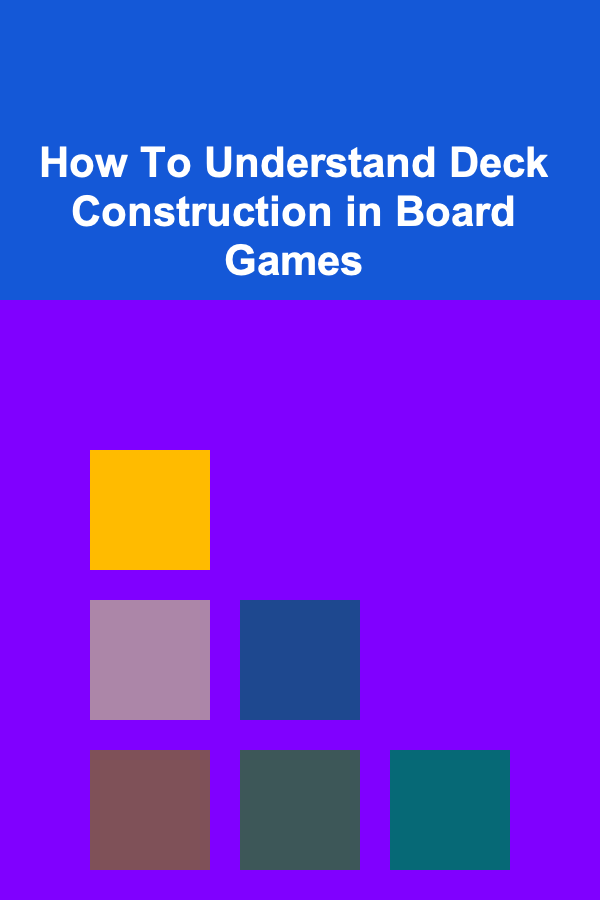
How To Understand Deck Construction in Board Games
ebook include PDF & Audio bundle (Micro Guide)
$12.99$6.99
Limited Time Offer! Order within the next:

Deck construction is one of the most fundamental aspects of many popular board games, particularly those in the genres of collectible card games (CCGs) and deck-building games (DBGs). Whether you're a seasoned player or a newcomer, understanding deck construction can significantly enhance your enjoyment of these games and improve your strategic thinking.
In this article, we will dive deep into the world of deck construction in board games, exploring its principles, strategies, and nuances. We will examine how to build effective decks, common pitfalls, and how different games implement deck-building mechanics. This comprehensive guide will equip you with the knowledge to construct decks that suit your playstyle and enhance your competitive edge.
What Is Deck Construction?
At its core, deck construction is the process of selecting and organizing cards in a way that maximizes your deck's performance in a game. Depending on the game, a deck can consist of cards that represent actions, resources, characters, items, or other game elements. The objective is to create a deck that aligns with your strategy, allowing you to consistently achieve your goals and overcome your opponents.
In collectible card games, deck construction is often tied to the concept of collection. Players build decks from their own pool of cards, each of which may have different rarities, abilities, and synergies. In deck-building games, however, the process is more structured. Players typically begin with a simple, limited deck and gradually enhance it during gameplay by acquiring new cards from a shared pool.
Types of Deck Construction in Board Games
Deck construction can vary widely depending on the type of game. Broadly, deck construction in board games falls into two categories:
1. Collectible Card Games (CCGs)
CCGs like Magic: The Gathering , Yu-Gi-Oh! , and Hearthstone revolve around the concept of deck construction, where players build decks using a vast collection of cards. In these games, players often need to balance different types of cards (spells, creatures, lands, etc.) and use synergies to create powerful combos that can win the game.
CCGs often include a "deck-building" phase that occurs before the game starts. In many of these games, players are allowed to bring their own decks, and the rules govern how many copies of each card can be included. CCG players spend significant time outside of actual play creating and refining their decks, a process that involves a deep understanding of the cards' interactions, game mechanics, and strategies.
2. Deck-Building Games (DBGs)
In deck-building games like Dominion , Clank! , and Star Realms, players begin with a weak deck, and over the course of the game, they improve it by acquiring new cards from a common supply. Deck-building games focus more on the in-game evolution of a player's deck rather than pre-game construction. The excitement of deck-building games often stems from the randomness of the cards available and the strategic decisions about which cards to add to one's deck.
While these games do not involve collection as in CCGs, they still require careful planning to ensure that the deck's composition leads to victory. In a typical DBG, players must carefully balance the cards they choose to add to their deck, ensuring that their deck is efficient, synergistic, and suited to the game's mechanics.
The Principles of Deck Construction
To create a successful deck, it is crucial to grasp several key principles of deck construction that apply to most card games. These principles help ensure that your deck is both functional and competitive.
1. Card Synergy
Card synergy refers to the way cards in your deck work together to create powerful combinations. A deck built with synergy in mind will often outperform a deck with a random selection of cards. For example, in Magic: The Gathering, cards with the "creature" type can be enhanced by cards that provide buffs, while cards with the "artifact" type can interact in unique ways with certain other cards. Building synergies requires a deep understanding of how the cards in your deck can interact with each other.
In deck-building games like Dominion, synergy is also important. For example, cards that allow you to draw more cards can be paired with cards that benefit from having more options, creating a cycle that leads to stronger turns.
2. Mana Curve (or Resource Curve)
The mana curve (or resource curve in some games) is a concept that refers to the distribution of cards by their cost. In games like Magic: The Gathering, players need to balance the number of cards with low, medium, and high costs. A mana curve helps ensure that your deck remains effective throughout the entire game. A well-balanced curve allows you to play cards efficiently in the early, mid, and late stages of the game.
In a typical deck, you want to have a majority of low-cost cards, with some mid-range and high-cost cards sprinkled in for later turns. This way, you won't find yourself in a situation where you can't play anything early in the game or overwhelmed by expensive cards that you can't afford.
3. Consistency
A key principle of deck construction is consistency. A deck that lacks consistency will often fail because it relies on too many random or unpredictable factors. For instance, in a CCG, if your deck is not built to draw cards effectively or to cycle through your key cards, you may find yourself frequently drawing suboptimal hands.
Consistency can be improved by including cards that allow you to draw more cards, search for specific cards, or control the game state. Decks that consistently deliver the cards you need to execute your strategy are typically more successful.
4. Resource Management
Most card games require the management of resources like mana, energy, or gold. Understanding how to efficiently use your resources is a critical aspect of deck construction. You want to ensure that your deck has the right balance of cards that help you generate resources and those that utilize those resources effectively.
In deck-building games, managing resources typically involves balancing cards that generate currency (like coins or energy) with those that allow you to buy more powerful cards. Overcommitting to one side---such as focusing too much on acquiring new cards---can leave you without enough resources to actually play those cards when you draw them.
5. Flexibility
While synergy is important, so is flexibility. A deck should be flexible enough to adapt to different opponents, strategies, and in-game situations. If a deck is too reliant on a specific strategy or card combination, it may become vulnerable to opponents who can disrupt that strategy. Balancing flexibility with synergy is key to building a deck that is both powerful and adaptable.
In some games, building flexible decks involves including a mix of offensive, defensive, and utility cards. For example, in a CCG like Hearthstone, you may include some cards for controlling the board early, but also cards that can finish off your opponent in the later stages of the game.
Deck Construction Strategies
1. Aggro (Aggressive) Decks
Aggro decks focus on dealing damage quickly and efficiently. They prioritize low-cost cards that can establish early board control and put pressure on the opponent right from the beginning of the game. The goal of an aggro deck is to win before the opponent can mount a significant defense or build up their own strategy.
In Magic: The Gathering , aggro decks often rely on fast creatures and spells that can deal direct damage. In Hearthstone, aggro decks may focus on low-cost minions that can attack quickly, while also including spells that can target the opponent's health directly.
2. Control Decks
Control decks are designed to withstand an opponent's early aggression while gradually building toward a powerful late-game strategy. These decks focus on removing threats, gaining card advantage, and controlling the flow of the game. The goal is to outlast the opponent and win in the long run.
In Magic: The Gathering , control decks often feature spells that counter the opponent's actions, such as counterspells, board wipes, and removal spells. In Dominion, control decks may prioritize cards that allow them to gain additional turns or access to more cards, gradually building up resources over time.
3. Midrange Decks
Midrange decks occupy a middle ground between aggro and control decks. These decks focus on efficient creatures and cards that allow for versatility in both offense and defense. Midrange decks aim to establish board control in the mid-game and then finish the game with powerful, scalable threats.
In Magic: The Gathering , midrange decks might use a mix of powerful creatures and spells that can provide card advantage. In Dominion, midrange decks might focus on cards that provide both resources and buying power, while also keeping options open for later turns.
4. Combo Decks
Combo decks focus on assembling specific card combinations that lead to powerful, game-winning effects. These decks are often built around synergies that, when combined, result in overwhelming success. Combo decks can be risky because they rely on drawing the right cards in the right order, but when they do work, they can be devastating.
In Magic: The Gathering , combo decks may rely on specific combos of creatures, artifacts, or spells that create infinite loops or deal massive damage in a single turn. In Dominion, combo strategies might involve cards that interact in unexpected ways, such as drawing cards and playing them multiple times in a single turn.
Conclusion
Deck construction in board games, whether in CCGs or deck-building games, is an art form that requires careful planning, strategic thinking, and a deep understanding of game mechanics. By mastering the principles of card synergy, mana curve, consistency, resource management, and flexibility, you can build decks that are not only competitive but also a reflection of your personal playstyle.
In addition, understanding different deck archetypes---like aggro, control, midrange, and combo decks---can give you a better sense of how to approach deck building depending on your goals. By focusing on these strategies and continuously refining your decks, you will be better equipped to navigate the exciting and challenging world of deck construction in board games.
Ultimately, deck construction is about finding the balance between creativity, strategy, and adaptability. Whether you're playing a CCG like Magic: The Gathering or a deck-building game like Dominion, a well-constructed deck can be the key to success.

How to Create a Cozy Home Without Overspending
Read More
How to Create a Timeless Bathroom Renovation
Read More
How to Develop a Volunteer Feedback System
Read More
How to Invest in Dividend Stocks to Generate Regular Income
Read More
How to Organize a Memorable Holiday Party at Home
Read More
How to Use Coupons and Discounts to Stretch Your Home Budget Further
Read MoreOther Products

How to Create a Cozy Home Without Overspending
Read More
How to Create a Timeless Bathroom Renovation
Read More
How to Develop a Volunteer Feedback System
Read More
How to Invest in Dividend Stocks to Generate Regular Income
Read More
How to Organize a Memorable Holiday Party at Home
Read More